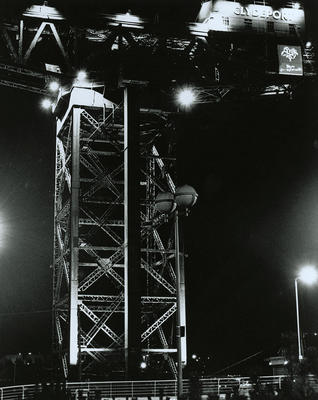
The Finnieston Crane, floodlit during the Glasgow Garden Festival in 1988. The crane was situated directly opposite the Festival site, which was on the south bank of the River Clyde. A straw locomotive by artist George Wyllie was hung from the end of the crane.
Originally known as the Stobcross Crane, it was built for the Clyde Navigation Trust by Cowans, Sheldon & Co of Carlisle in 1932. The cantilever crane stands 195 feet high and has a hammerhead jib of 152 feet. It was used to transfer boilers and engines into new vessels and load heavy machinery such as railway locomotives onto freighters.
In the 1980s the crane came to be regarded as a symbol of Glasgow's industrial past. Although seldom used for its original purpose, the crane is still in working order. In the past it has been used to load tanks onto ships, and could do so again, should the need arise. It is sometimes used for fundraising events such as abseiling.
Reference: Illustrations vol.35B, p.11
Reproduced with the permission of Glasgow City Council, Libraries Information and Learning
Keywords:
abseiling, cantilever cranes, Clyde Navigation Trust, Clydeport, Cowans, Sheldon & Co, cranes, Finnieston Crane, floodlighting, fundraising, Glasgow Garden Festival, hammerhead cranes, marine engineering, railway locomotives, River Clyde, shipbuilding, ships, Stobcross Crane, straw locomotives, tanks
You have 0 images in your photo album.